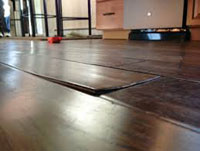Quick reference guide for hardwood tools & definitionsAbove Grade A suspended floor located above ground level, with a minimum of 18 inches of ventilated air space below. Normally above a basement, but a suspended floor may also be above a crawl space. Abrasion...
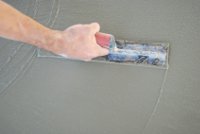
Why Flooring Professionals Must Always Test For Excessive Moisture And Alkalinity
Why Flooring Professionals Must Always Test For Excessive Moisture And Alkalinity
It’s no mystery. The leading cause of flooring failures is moisture.
Industry experts say approximately 85% of all installation failures result from moisture problems. In fact, moisture accounts for more than $1 billion in damages annually.
Moisture can cause a wide range of hardwood flooring problems that may occur soon after installation or, in some cases, months or even years down the road. These problems include cupping, buckling, blistering, crazing, adhesive failure or delamination, warping, scaling, pop-outs, efflorescence, discoloration, gaps or cracks, swollen joints, and even mold or mildew growth.
The reason moisture is the root cause of many flooring failures is simple. Concrete slabs, wood subfloors, and the wood flooring placed above a slab or subfloor are by their very nature porous. So they easily absorb and release moisture.
While it’s critical to ensure hardwood flooring reaches its equilibrium moisture content (EMC) with the air (that is, attain an optimum moisture level before installation), it’s equally – and perhaps even more – important to accurately measure the moisture content of the concrete. Why? Because moisture passing from or through concrete has become the number one cause of floor covering failures in this country.
For that reason, most U.S. producers of floor coverings, adhesives and resinous coatings require accurate moisture testing of both concrete and wood in order to avoid flooring failures.
It’s important then that wood flooring professionals have an understanding for the need of both concrete and wood floor moisture testing. They should also know the difference between the two recognized concrete test methods and the two types of hardwood moisture meters.
Let’s look at how moisture affects concrete before moving on to moisture’s effect on wood flooring.

Concrete and Moisture
Concrete is porous material. The more porous it is, the greater the potential for moisture vapor to move at a volume harmful to the floor covering. Concrete slabs with a high moisture emission rate and/or too high a pH level will always be detrimental to a successful flooring installation.
Excess moisture in concrete can occur for various reasons:
- There may be too much water in the concrete mix
- Too little curing or drying time
- Rainfall from incomplete roofing systems
- Lack of HVAC climate control
- Poor landscaping that fails to drain water away from building foundations.
- Buffing the concrete smooth to iron out imperfections that may “telescope” into the floor covering. This practice hinders drying time because it seals the concrete’s pores.
High Alkalinity and Time
A related problem to excess moisture – too much alkali. High alkalinity destroys the bond between the adhesive and floor covering. High alkalinity occurs when too much moisture moves through the slab.
Alkalinity is a natural constituent of all concrete. The good: the internal alkaline state of concrete prevents reinforcing steel from rusting. The bad: when the surface of a concrete slab has an alkalinity above 9 on a pH scale (usually 10 and above), adhesive and bonding systems can be compromised.
To ensure concrete is at the proper state of alkalinity, testing with pH paper or a pH meter must be performed. Moisture causes damage, but moisture at a high pH is disastrous.
Still another problem is time. Many building contractors work on a fast-track construction schedule. As a result, concrete is not given enough time to naturally dry before installation of floor covering materials and coatings.
Making matters worse, is the use of curing compounds which inhibit or prevent concrete from drying . . . and the use of floor covering adhesives and coatings which are more sensitive to moisture and alkali assault than previous materials.
Keep in mind, flooring installers are attempting to adhere floor covering materials using water based adhesive systems to a water-based agglomerate called concrete. Excessive moisture emission from concrete that has not sufficiently dried will almost always interfere with the ability of an adhesive to bond or cure properly.
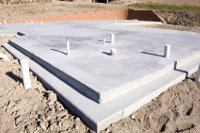
Concrete versus Cement
To avoid confusion, it’s important to distinguish “cement” from “concrete.” Though they’re often considered the same thing, they are not. Cement powder is the material, typically grey, combined with sand, water, gravel, or crushed stone to make concrete. Concrete, therefore, is a combination of cement and aggregate materials.
There are two types of cement: hydraulic cement and non-hydraulic cement.
Hydraulic cement (e.g., Portland cement) hardens by reacting with water to form a water-resistant product. It sets extremely fast and hardens even under water. It’s used to stop water and leaks in concrete and masonry structures, and is used widely where structures are submerged in water.
Non-hydraulic cement (e.g., lime and plaster of Paris) cannot harden while in contact with water. It must be kept dry to gain strength and hold the structure. When used in mortars, those mortars can set only by drying out, and therefore gain strength very slowly.
Both types of cement can be combined with fly ash, lime, silica fume, blast furnace slag, and other additives to give a variety of strengths and colors to the various cement blends.
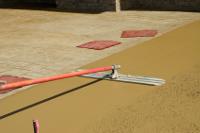
Curing versus Drying
When cement is mixed with sand, water, and aggregate, a chemical reaction occurs binding the materials together to form concrete. It takes roughly four weeks for this chemical process to be complete in a 4-inch slab. This process is called “curing.”
It’s a common misconception to say that concrete dries when actually it’s curing. Curing is not the same thing as drying.
Curing requires adequate moisture, temperature, and time to allow the concrete to achieve its desired properties. When a slab is considered “cured,” it still holds an appreciable amount (about two-thirds) of the moisture from the original concrete mixture. Obviously, this is way too much to install a flooring product over, so the concrete needs additional time to dry thoroughly.
A concrete slab typically cures in 28 days. Drying time continues after curing – about one month for each inch of slab thickness.
So even after curing, drying continues. Moisture moves through the slab to the surface where it then evaporates. It will, however, be replaced by more moisture drawn up through the entire slab.
Thus, it’s important to keep in mind that even when a slab may be considered cured or even “dry,” it may not be fully dry enough. Environmental conditions like temperature and air humidity can affect the drying process.
It’s imperative then that accurate moisture testing be done to ensure the slab is dry enough to apply a floor covering.
Under certain conditions, engineered wood flooring may be able to be installed directly over concrete or in below grade applications. This is something that cannot typically be done with solid wood floors. However, vapor transmission testing must be done first to determine if the level of concrete slab vapor emissions or hydrostatic pressure is acceptable. If not, excessive moisture in a basement slab or concrete slab can ruin an engineered wood flooring installation.

Floor Covering Problems
When a floor covering shows signs of moisture-related failures, the problem is likely due to one of the following;
- The concrete slab has a higher moisture emission rate than the floor covering can tolerate.
- The concrete was not cured or dried sufficiently before installation of the floor covering.
- No moisture testing was performed or it wasn’t done correctly.
- The moisture testing didn’t show future concrete slab behavior.
- Alkalinity is too high in the concrete due to a high moisture emission rate.
Alkalinity is measured by pH from 1-14. Ideally, concrete should have a pH of 7-9 before installing a floor covering; otherwise, the high alkalinity (high pH) combined with moisture will destroy flooring adhesive bonds.
Freshly mixed concrete is highly caustic and extremely alkaline – well above 10. This condition may compromise adhesives and flooring materials. As concrete ages and reacts with carbon dioxide in the air (part of the curing process), the alkalinity (or pH level) of its surface gradually decreases.
Before flooring is installed, the pH level of the concrete surface should be between 7-9. However, flooring installers should check the pH level recommended by the adhesive manufacturer as well as other manufacturers’ products that might be used on the subfloor, such as moisture barriers, epoxy coatings, and leveling compounds.
ASTM states that a pH test should be performed along with every moisture test. Many flooring manufacturers require pH testing be conducted before flooring is installed.
Measuring pH
There are a couple of ways to measure pH. One way is to use paper test strips which change color according to the alkalinity of the concrete. But a more accurate way is to use a pH meter, which gives a numerical reading on a digital display.
To test pH, one must:
- Sand a small section of the concrete surface with 200 grit sandpaper. This removes any impurities from the surface that might affect the test results.
- Remove the dust with a vacuum cleaner.
- If the surface doesn’t pass the water drop test, that is, the surface is still not porous after sanding, the non-porous material will have to be removed using a hand grinder. If the water beads on the surface, it will not give an accurate pH reading because only the water drop itself will be tested
- Put several drops of distilled or deionized water on the prepared surface. Use the test strip or meter to see if the water has a pH reading of 7 before using it.
- Leave the drops on for 60 seconds and then place the test strip or meter in the water. Wait for the period of time specified by the manufacturer.
- If test strips are used, compare the color of the strip to the pH color chart. Or, if using a pH meter, read the meter’s digital display.
Proper and Accurate Concrete Moisture Testing
Testing concrete for moisture must not be done haphazardly. In order to attain accurate results, proper testing procedures must be followed to avoid costly problems later.
For instance, testing the slab’s surface only once is inadequate when trying to make an intelligent decision about installing flooring. Since a slab may dry unevenly, proper testing should include a number of different spots on the slab as well as below the slab’s surface.
Also, a combination of tests is better than a single test. The American Society for Testing and Materials (ASTM) has written standards for testing moisture content using two different test methods: Calcium Chloride testing (ASTM F1869) and In-Situ Relative Humidity testing (ASTM F2170).
There is a growing number of floor covering manufacturers suggesting or requiring both of these tests to determine dryness and suitability for installing their products.
Calcium Chloride Test ASTM F-1869
The calcium chloride test, long considered the standard for testing concrete moisture vapor emissions, has been in use since the 1940s. This test produces a moisture vapor emissions rate (MVER), which is a reading of how much moisture content is released from 1000 square feet of concrete slab over a 24-hour period. The results are expressed as pounds of moisture.
As a desiccant, calcium chloride absorbs moisture from the air. Typically, a small plastic dish of anhydrous calcium crystals is weighed on a gram scale before placement to determine moisture content. The weight, date and time the test was started is recorded. The dish of crystals is placed on the concrete for 60 to 72 hours, covered, and sealed with plastic tape to the concrete.
During this time, the only source of moisture absorbed by the anhydrous crystals is what can evaporate out of the covered concrete surface area. At the end of the test, the cover is removed and the lid is placed back on the dish and sealed. Again the dish is weighed on the gram scale and the date and time are marked. The change in weight is multiplied by a constant and divided by hours to provide an estimated rate of evaporation in pounds.
For example, water weighs 8.3 pounds per gallon. “Pounds” is the equivalent weight of water that evaporates out of a 1,000 sq. ft. surface area during 24 hours. If the test reports 8.3 pounds emission, then one-gallon of water is leaving a 1,000 sq. ft. surface area in 24 hours. When flooring is to be installed, an allowable amount of moisture emission, as expressed by the calcium chloride test, is 3.0 pounds per 1000 sq. ft. per 24 hours.
For new construction, ASTM requires 3 kits for the first 1,000 sq. ft. and at least 1 kit for each additional 1,000 sq. ft. The temperature of the surface should be between 50-70º F. The internal conditions in the room should be 40-60% humidity and 65-85º F.
Shortcomings of the Calcium Chloride Test
The Calcium Chloride test, however, is not foolproof. It has a number of shortcomings, and as a result, some floor manufacturers no longer recognize Calcium Chloride test results for determining concrete dryness.
Here are some of the cons for the Calcium Chloride test:
- Too many tests are being set without floor preparation as required by ASTM F1869. Surface contaminants and residue from paint, adhesive curing or parting compounds can reduce vapor emission at the test site and produce inaccurate test results. In short, the concrete pores must be open.
- It requires a specified waiting period and the correct number of tests performed based on square footage. This test measures vapor emissions at the time of testing, which can change as the building environment changes.
- It measures moisture vapor emissions only from the top ¼” to ½” of the slab, so it doesn’t indicate moisture deep in the slab. If ambient environmental conditions immediately preceding testing have been extremely wet or dry, the concrete surface may be affected and test results may be skewed.
- The subject building must be acclimated at or near the temperature and relative humidity levels anticipated during occupancy or use. This is often a difficult requirement to meet on a new construction project. Significant variance between the test environment and intended use environment should cause test data to be questioned.
- The most current revision of ASTM F1869 specifically excludes Calcium Chloride tests from use on lightweight aggregate concrete.
- “Homemade” Calcium Chloride test kits are being used and in some cases by very reputable labs. Some of these kits do not meet the apparatus requirements of ASTM F-1869-09 and are delivering questionable results.
In-Situ Relative Humidity Testing ASTM F-2170
ASTM Committee F.06 on Resilient Flooring has developed and published a standard for In-Situ Testing of Concrete Relative Humidity. This test method has been used extensively in Europe. It enables flooring professionals to check the moisture level within a concrete slab through relative humidity (RH) testing using in situ probes.
After side-by-side testing with Calcium Chloride kits, there is evidence that the In-Situ Relative Humidity (RH) data is more useful and meaningful than Calcium Chloride test results. In other words, RH probes are less sensitive to changes in ambient air humidity and temperature above the slab than calcium chloride testing.
In that regard, In-Situ RH testing provides more meaningful data under conditions that may not be acceptable for Calcium Chloride testing. As a result, some industry experts believe this test is a more accurate way of predicting what will happen to the slab in the future.
Probes Are Inserted Into The Slab
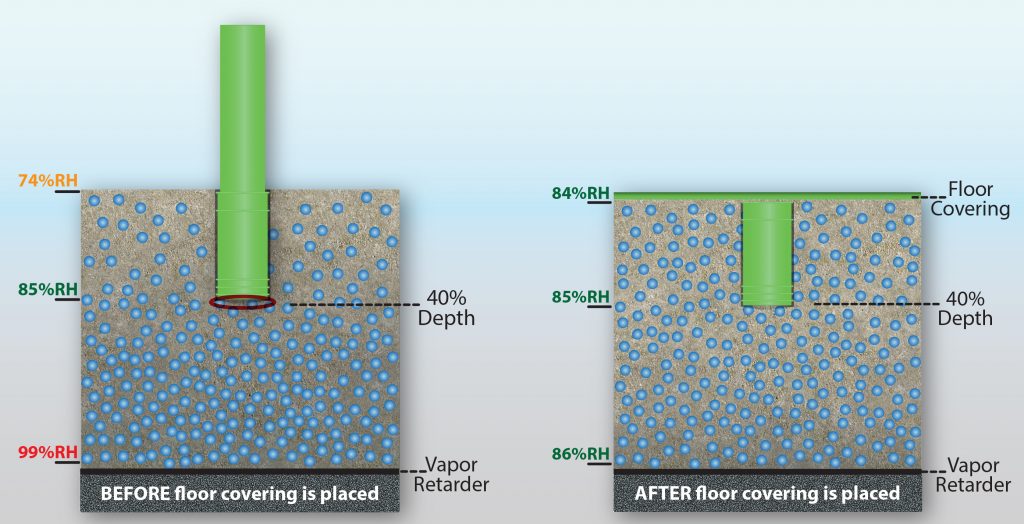
This test involves drilling holes at a diameter of 5/8” to a depth equal to 40% of the slab thickness. The hole is then lined with a plastic sleeve and the sleeve is capped. The test site must be permitted to acclimate for 24 hours before reading relative humidity levels.
After or during acclimation or equilibrium, a probe is placed in the sleeve that permits readings to be obtained from the bottom of the hole, thus offering a method to measure moisture content inside of the concrete slab reported as a relative humidity level.
It is critically important that probe sensor temperature is at equilibrium with concrete slab temperature. Testing should take place in an acclimated building and at the same test placement density as noted above.
This concrete moisture test method is less affected by conditions occurring at the concrete surface, which may negatively influence Calcium Chloride test results. Consequently, this test provides the best picture of the moisture conditions the adhesive and finished flooring product would encounter if they were installed at that time.
In-situ RH testing performed at multiple depths permit a testing agency to develop a profile of moisture conditions through the thickness of a concrete slab. This information permits the user to make a more informed decision regarding the installation of floor coverings or the need to consider other alternatives.
The water content in concrete migrates from the bottom of a slab to the surface, where it evaporates according to changes in RH. It’s imperative, therefore, that the concrete’s internal moisture be allowed to dry to the proper level in order to avoid problems with adhesives and flooring products after installation.
Unfortunately, many builders mistakenly believe that surface moisture content levels reflect those of the whole slab. They neglect internal slab moisture levels. A concrete moisture meter will tell them relative moisture on the surface, but only relative humidity (RH) testing gives them an internal, and more accurate, assessment.
Although relative humidity test probes are not sold as reusable (some are, but require re-calibration for each test site), the sensors remain intact. They can be re-used over and over.
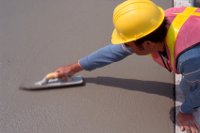
RH Test versus Calcium Chloride Test
In terms of cost-efficiency, relative humidity testing is better than anhydrous calcium chloride testing. Calcium Chloride test materials must be discarded after each test procedure is complete. This means new kit test costs. Relative humidity testing, however, produces multiple sites throughout a concrete slab which can be assessed repeatedly.
One advantage of the RH test is that it’s less impacted by ambient temperature and relative humidity conditions than calcium chloride type tests. Thus, conditions that are not acceptable for calcium chloride testing may not generate meaningful data.
Wagner Meters, with its state-of-the-art Rapid RH® system for RH testing, saves on total material costs and preparatory work for flooring installers. The Rapid RH in-situ test method saves more than 150 hours of installation time (based on industry estimates for 13 slab tests).
Here is a breakdown of time (cost) savings:
- Preparation: 130 minutes
- Site protection: 120 minutes
- Test processing: 125 minutes
- Clean-up: 13 minutes
Smart Sensors equilibrate to produce meaningful RH data within one hour of installation, though the ASTM standard requires a 24-hour reading before making an installation decision. The Wagner Meters’ Smart Sensors continue to digitally read moisture content levels at the point of installation. This enables builders to repeat tests at each test location on site to capture an ongoing RH assessment. Project managers for large commercial construction projects find this to be especially valuable.
The Rapid RH offers multiple benefits. Users realize built-in cost savings since the system offers the lowest cost per test than other In-Situ RH test systems, plus lower time and labor costs. It’s also easy to use and 10 times faster than other RH tests.
Once installed, the Smart Sensor and Easy Reader work together to provide accurate, instant readings at a touch. And, the new, award-winning Rapid RH Datamaster helps streamline data records and ASTM-compliant reports.
Wagner Meters’ Rapid RH system offers flooring and building professionals the concrete moisture data they need to meet ASTM F2170 standards. And each disposable smart sensor comes with an NIST traceable factory calibration certificate, providing reliable accuracy and completely eliminating the need for periodic calibrations typically required by other sensing technologies.
In addition to meeting industry standards, the Rapid RH system also has received impressive industry accolades and reviews.
Other Common Tests
There are other tests that can be used to determine moisture and alkalinity levels, but they are not quantitative like the calcium chloride or in-situ relative humidity tests. Although they may indicate the presence of moisture or alkalinity, many flooring manufacturers insist that one or both of the ASTM endorsed tests be conducted to satisfy their requirements.
These other tests include:
Polyfilm Test
In this test, several pieces of plastic film, 18” – 24” square, are placed at key points on the cement, then sealed with silver duct tape on all four sides. The plastic film is removed after 24 hours (72 hours is better) and inspected for signs of condensation. Use of a heat source, such as a 40 to 60 watt light bulb placed 18” above the plastic “accelerates” this test.
If beads of water are found on the subfloor or the concrete appears darker, this serves as notice that further testing is necessary. Installation can proceed if there’s no indication of moisture.
Phenolphthalein Test
This test requires drilling dime-sized 1/4-inch deep holes in various areas of the slab, especially around the walls, and then applying in each hole two drops of a 3 percent phenolphthalein solution in water-free ethyl alcohol. If there’s no color change in the solution, this means moisture and alkalinity are not at levels to affect the installation.
Should the phenolphthalein turn pink or dark red within five minutes and the pH is 9.0 or higher, further testing must be done with a more precise method.
Wood Subfloor
Improper moisture conditions in a wooden subfloor can also lead to moisture-related problems associated with a concrete slab. Flooring specialists can test the moisture content of a wood subfloor using the pinless wood moisture meter. Similar to the hardwood floor, the wood subfloor must have an acceptable moisture content to avoid flooring failures over time.
Flooring specialists should test several areas of a wood subfloor to be certain conditions are acceptable for the final flooring installation. A good rule of thumb is that the subfloor moisture content should be within 3-4 percentage points of the flooring to be installed before proceeding.
Wood Flooring
Regardless of whether hardwood or engineered flooring is to be installed, all material should be checked with an accurate wood moisture meter. This involves opening and testing several bundles to ensure the wood flooring is the same MC throughout, and is compatible with the subfloor which the flooring will cover when installed.
As with the wood subfloor, pin-style and pinless meters can give an indication of the MC to ensure a professional and long-lasting flooring installation.
The pinless meters haves some unique advantages over the pin-style meters. Since they don’t use pins, they won’t damage the wood flooring with unsightly pin holes. That means no filing or sanding on the final floor. They also enable installers to measure entire bundles in a matter of seconds.
The Wagner Meters Orion line are pinless floor moisture meters which offers flooring professionals a versatile range of options for measuring and monitoring wood moisture content. Considered one of the world’s most accurate hardwood moisture meters based on third-party and university tests, it comes with dual-depth reading options and Wagner’s signature IntelliSense™ technology for accuracy that is virtually unaffected by surface moisture.
The Orion floor moisture meter also features a specific gravity (SG) range that covers most wood species including dense, tropical species. It provides a moisture measuring range of 5% to 30%. And, it displays moisture readings to one-tenth of a percent (0.1%) resolution on an easy-to-read digital display.
Moisture levels in the average household are considered to be between 6-9% and wood flooring is generally dried to this level. But regional and seasonal variations mean that even wood flooring manufactured from properly-dried lumber will need an acclimation in the installation environment to prevent extreme changes in the finished floor. For instance, even a change as small as 1/32” per 2” board multiplied across an eight-foot room equals 1 ½” of gapping or swelling.
In Closing . . .
All flooring professionals need to be proactive when it comes to proper installation of wood flooring. Accurate moisture testing is their best defense against moisture-related flooring failures that can lead to wasted time and financial loss . . . and even a tarnished reputation.
Hopefully, this article has provided a basic understanding of why moisture testing is extremely important, and why it applies not only to the wood flooring, but also the concrete slab and wood subfloor.

